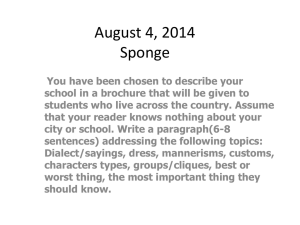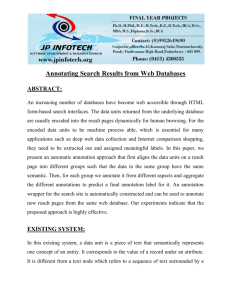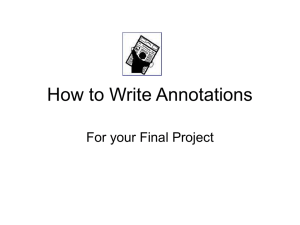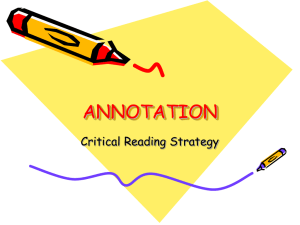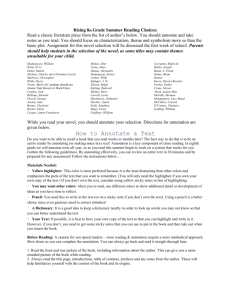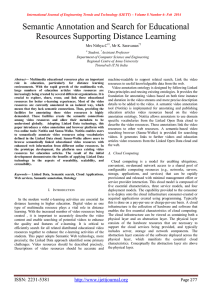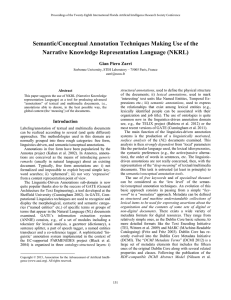modules - JP InfoTech
advertisement
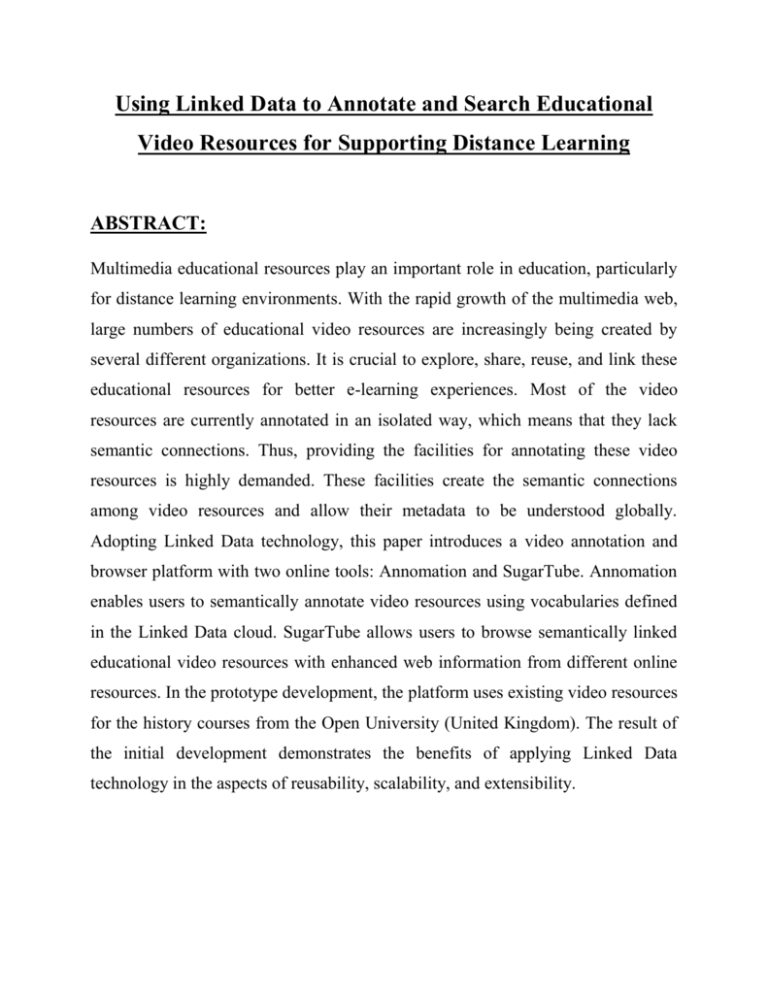
Using Linked Data to Annotate and Search Educational Video Resources for Supporting Distance Learning ABSTRACT: Multimedia educational resources play an important role in education, particularly for distance learning environments. With the rapid growth of the multimedia web, large numbers of educational video resources are increasingly being created by several different organizations. It is crucial to explore, share, reuse, and link these educational resources for better e-learning experiences. Most of the video resources are currently annotated in an isolated way, which means that they lack semantic connections. Thus, providing the facilities for annotating these video resources is highly demanded. These facilities create the semantic connections among video resources and allow their metadata to be understood globally. Adopting Linked Data technology, this paper introduces a video annotation and browser platform with two online tools: Annomation and SugarTube. Annomation enables users to semantically annotate video resources using vocabularies defined in the Linked Data cloud. SugarTube allows users to browse semantically linked educational video resources with enhanced web information from different online resources. In the prototype development, the platform uses existing video resources for the history courses from the Open University (United Kingdom). The result of the initial development demonstrates the benefits of applying Linked Data technology in the aspects of reusability, scalability, and extensibility. ARCHITECTURE: EXISTING SYSTEM: With the rapid growth of the multimedia web, large numbers of educational video resources are increasingly being created by several different organizations. It is crucial to explore, share, reuse, and link these educational resources for better elearning experiences. Most of the video resources are currently annotated in an isolated way, which means that they lack semantic connections. Thus, providing the facilities for annotating these video resources is highly demanded. With the rapid growth of the multimedia web, a large number of free educational resources are also available on the web. Therefore, it is crucial to gain the capability to efficiently search for all related distributed educational resources together to allow them to be used to enhance the learning activities. DISADVANTAGES FOF EXISTING SYSTEM: In the existing system Video resources are not described precisely. The descriptions of the educational resources are not accurate and not machine-understandable, so it does not support search functionality. PROPOSED SYSTEM: 1. A video annotation ontology is designed by following Linked Data principles and reusing existing Ontologies. It provides the foundation for annotating videos based on both time instance and duration in the video streams. This allows more precise description details to be added to the video. 2. A semantic video annotation tool (Annomation) is implemented for annotating and publishing educational video resources based on the video annotation ontology. Annomation allows annotators to use domain specific vocabularies from the Linked Open Data cloud to describe the video resources. These annotations link the video resources to other web resources. 3. A semantic-based video searching browser (Sugar-Tube) is provided for searching videos. It generates links to further videos and educational resources from the Linked Open Data cloud and the web. ADVANTAGES OF PROPOSED SYSTEM: 1. The initial learning content management systems do not need to be changed but only adding the extra semantic annotations to the existing data, then the learning resources will be linked and become parts of the Linked Data Cloud. 2. Annotations are accurate and free of spelling errors, ambiguity, and multilinguality issues. 3. The semantics of the annotations are processable by machine, which fosters the accuracy of searching and collecting related learning resources. 4. The educational resources from different educational institutions are shared, reused, and semantically connected. MODULES: Domain Experts / Course Creator Module Tutors and Student Module Annomation Module SugarTube Module Linked Data Technology Module MODULES DESCRIPTION: Domain Experts / Course Creator Module: In this module we develop the entity of domain experts / course creator module, where, the domain experts who are specialists in identifying items on the video for certain courses. In our prototype development, the experts are people working in the history department who are familiar with the OU video collections; course creators who are in charge of defining the syllabus and teaching plans for certain courses. DOMAIN EXPERTS UPLOAD VIDEO COURSE CREATOR Tutors and Student Module In this module we develop the tutors and student module, where the tutors who execute the syllabus and teaching plans to create the detailed teaching materials and provide support for students within the distance learning environment; students are the learners who take the distance learning courses. TUTORS UPLOAD VIDEO DB RETREIVAL STUDENTS SEARCH Annomation Module: Video annotation ontology is designed by following Linked Data principles and reusing existing ontologies. It provides the foundation for annotating videos based on both time instance and duration in the video streams. This allows more precise description details to be added to the video. 2. A semantic video annotation tool (Annomation) is implemented for annotating and publishing educational video resources based on the video annotation ontology. Annomation allows annotators to use domain specific vocabularies from the Linked Open Data cloud to describe the video resources. These annotations link the video resources to other web resources. SugarTube: Module SugarTube provides an online browsing platform that allows tutors and students to browse and search videos that are annotated by Annomation. It offers both syntactic and semantic search functionalities. The semantic search API not only finds video from the OU video repository but also delivers any linked educational resources from the Linked Open Data cloud to the user interface. The syntactic search offers more syntax-based related educational resources from the web. Linked Data Technology Module: Traditional video annotations using free-text keywords or predefined vocabularies are insufficient for a collaborative and multilingual environment. They do not properly handle the annotation issues, such as accuracy, disambiguation, completeness, and multilinguality. For example, free-text keywords annotation easily fails on accuracy issues as they may contain spelling errors or be ambiguous. Furthermore, they are insufficient for a collaborative and multilingual environment. Our approach uses Linked Data to tackle the above issues in video annotations. It brings the following benefits. . Each vocabulary is controlled and accurately defined in the Linked Data Cloud. It owns a unique URI to distinguish it from other vocabularies, so there are no conflicts between different vocabularies and meanings. The Linked Open Data Cloud, which has the most complete data sets to describe the current world, helps to find a good number of related educational resources. SYSTEM REQUIREMENTS: HARDWARE REQUIREMENTS: • System : Pentium IV 2.4 GHz. • Hard Disk : 40 GB. • Floppy Drive : 1.44 Mb. • Monitor : 15 VGA Colour. • Mouse : Logitech. • Ram : 512 Mb. SOFTWARE REQUIREMENTS: • Operating system : Windows XP. • Coding Language : ASP.Net with C# • Data Base : SQL Server 2005 REFERENCE: Hong Qing Yu, Carlos Pedrinaci, Stefan Dietze, and John Domingue, “Using Linked Data to Annotate and Search Educational Video Resources for Supporting Distance Learning”, IEEE TRANSACTIONS TECHNOLOGIES, VOL. 5, NO. 2, APRIL-JUNE 2012. ON LEARNING
